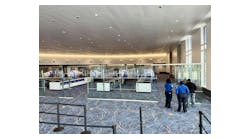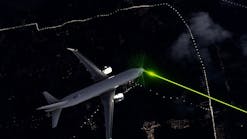Protecting an airport goes well beyond implementing new infrastructure or hardening facilities.
One of the biggest factors in a high quality security program means situational awareness of what’s taking place across the terminal, airfield and beyond to understand what’s happening, where and by whom; or simply having a proactive knowledge of what could take place.
Airport Business recently spoke with ELERTS CEO Ed English and Intelligence Analyst David Bruce about what situational awareness really means in airport operations and what airports can do to ensure effective knowledge of the workings of their facilities.
Airport Business: What does awareness mean in an airport setting? How does an airport gauge awareness?
David Bruce: An airport is very much like a city and many different types of behavior can be observed there from day to day. Every venue has its own baseline of what’s normal and what exists outside that baseline. Awareness means being alert to suspicious behaviors and hazards. Traveling causes a great deal of anxiety for many people so a lot of times seeing people that are anxious or running for a flight they are about to miss doesn’t necessarily stand out in that environment. Awareness to me means picking up the threats that are less obvious to everyone – tape over a door latch, or a car in the airport garage with no license plates. Or in one scenario that came in through our reporting of a woman washing a bucket of rocks in the bathroom.
An airport can gauge awareness by the type of incidents that are being reported. For example, how many reports of insider threat activity do they receive? Or reports of unauthorized people entering secured areas, or human trafficking? We know these things are happening, but if there is little or no reporting on these types of events, the airport is likely missing a lot of information/intelligence that they should be capturing.
Awareness can also be gauged by how long it takes for a broken escalator to get reported. We see how dangerous these incidents can be – a good indicator can be gained by rolling back the camera footage and seeing how long it took for that reporting to make its way to a control center. If a passenger’s only option is to call 9-1-1, they will probably not report unsafe conditions until an actual emergency happens.
AB: Explain the benefits of enhanced awareness for an airport when it comes to security?
DB: Awareness is everything and timely awareness is the gold standard. Like cities, airports have the capabilities to respond to just about any incident, but capability and performance are two different things. Many airports have groups that specialize in terrorism, smuggling and human trafficking. They also have fire and emergency medical assets embedded. But in a case of suspicious activity, unless someone reports it, these assets remain unaware. That’s why crowdsourcing is such a force-multiplier. Having a steady stream of actionable intelligence from travelers and employees is crucial.
AB: How do you see technology reshaping how airports can monitor situational awareness?
DB: I mentioned earlier, crowdsourced information is crucial. To gather it with success, we must meet passengers and employees where they already are: their mobile phones. I see airports turning to technology that complements the systems already in place. The technology exists in mobile phones to geolocate, transmit media and activate cameras in areas of reporting. That is the future of situational awareness in transportation and it’s already a proven asset in many transportation venues. When we leverage information from passengers and employees, we create an environment where we move from reactive to proactive. Proven technology implemented correctly and used to its fullest potential makes everyone safer.
AB: What types of datapoints can crowdsourcing information from employees provide that enhance other programs and technologies used to monitor airport facilities?
Ed English: When a crowdsourced report is sent for some type of activity that needs a response or attention, it’s important to get eyes on that location immediately. Many organizations have a network of cameras that number in the thousands. Finding the one “right” camera can be like finding a needle in a haystack. To pinpoint locations and gain visibility we created the Attention Engine. This technology instantly pinpoints the nearest camera and offers control room staff use of that camera. This reporting system integrates well with already-in-place workflow systems like IBM Maximo and Veoci.
When systems are built to work seamlessly with other systems, they form a strong network. We need systems that talk to each other. For instance, we see a lot of lower-level events that need attention. Not only can the Attention Engine identify a camera nearby an incident, it can also identify a nearby PA speaker. Armed with this information, a dispatcher can view the camera to see who is causing the problem and then activate a nearby PA speaker horn. The dispatcher can then give instructions to an individual that is, let’s say – smoking in a non-smoking area or unwittingly approaching a restricted area. “Attention, man in the red sweater, there is no smoking in this area.” Many low-level events do not require a physical response and can be mitigated remotely so responders can focus on more pressing issues.
AB: To build high quality crowdsourcing information inside an airport terminal, how does an airport determine who should have access to reporting tools? What are the standards they should put in place?
EE: The more people that have access to information the better off we are. With that said, we typically route information to appropriate departments. We can route to anyone that is in the system, including fire/rescue, police, security, and maintenance. For example, many airports get reports about issues involving people experiencing homelessness. To better address this issue, we can route these reports to the homeless ambassador staff.
We are forever evolving. While reports normally funnel into a control room, there are certain key words that an airport can establish. Then, whenever those words are on a report we courtesy-copy key employees. This capability serves airports two-fold. First, it gives them instant notification on issues they deem critical and second, it allows specified users to be omitted from lists of routine events.
AB: How can crowdsourcing information be used to mitigate issues outside of situational monitoring, such as insider threats?
EE: By providing employees with a means to report suspicious activity, we include the people who have more direct and better understanding of what is normal and what is abnormal. We get reports of piggybacking, duct tape on secure door latches, and even reports of coworkers who are experiencing stress.
No Situational Awareness program is complete without employees. They have an incredible vantage point and access to areas that the public can never have. Their access and reporting really completes the 360 degrees of awareness. For example, we had a situation where an employee was making firearms parts using a company’s 3-D printer. Another employee saw him, reported it, and it allowed a serious violation to be addressed before it escalated into an incident. We also receive reporting of safety issues such as inadequate light in a secured area to be able to see whether workers in the SIDA Area have badges displayed.
One of the key takeaways for all these reports and events is that they are pre-incident. The airport is able to capture information and awareness to be proactive rather than reactive.




